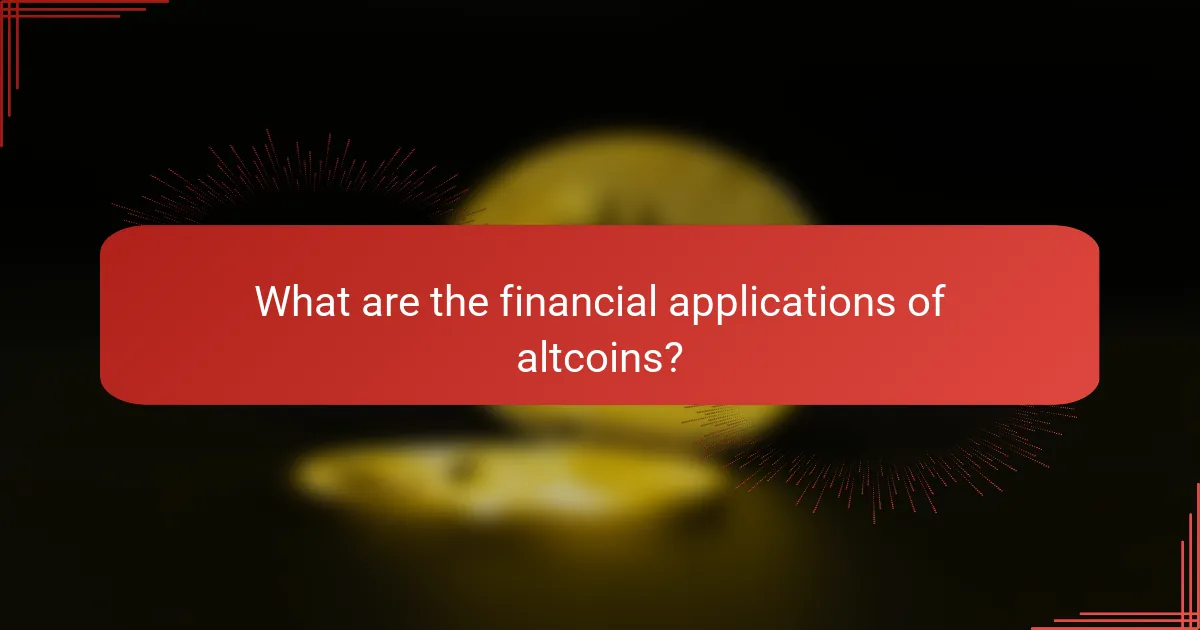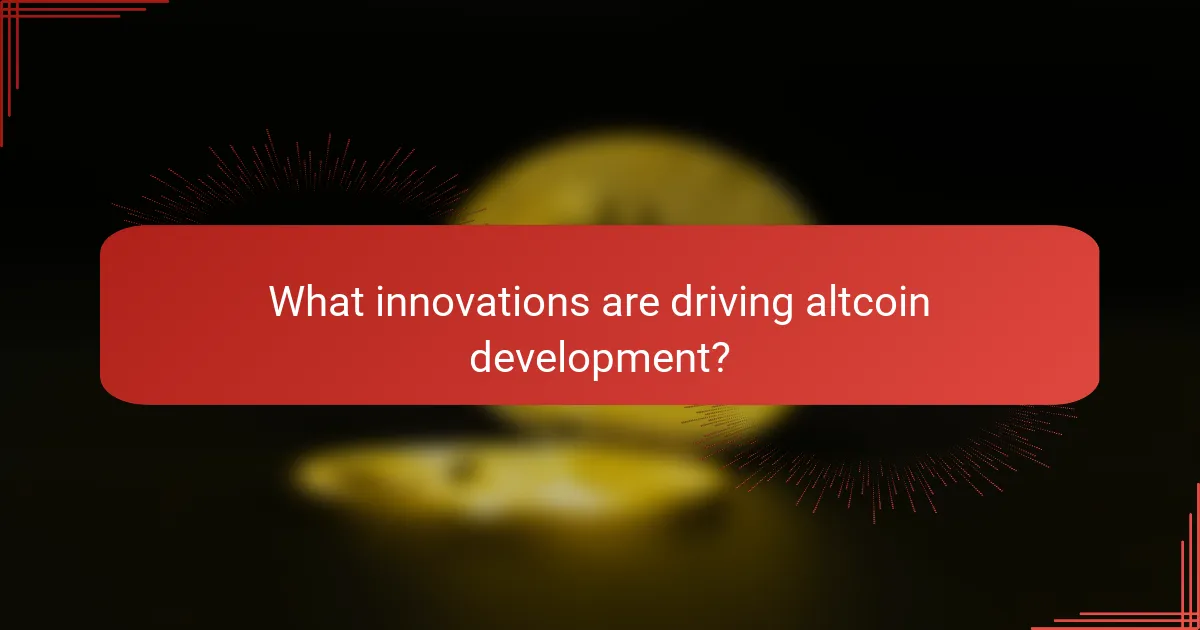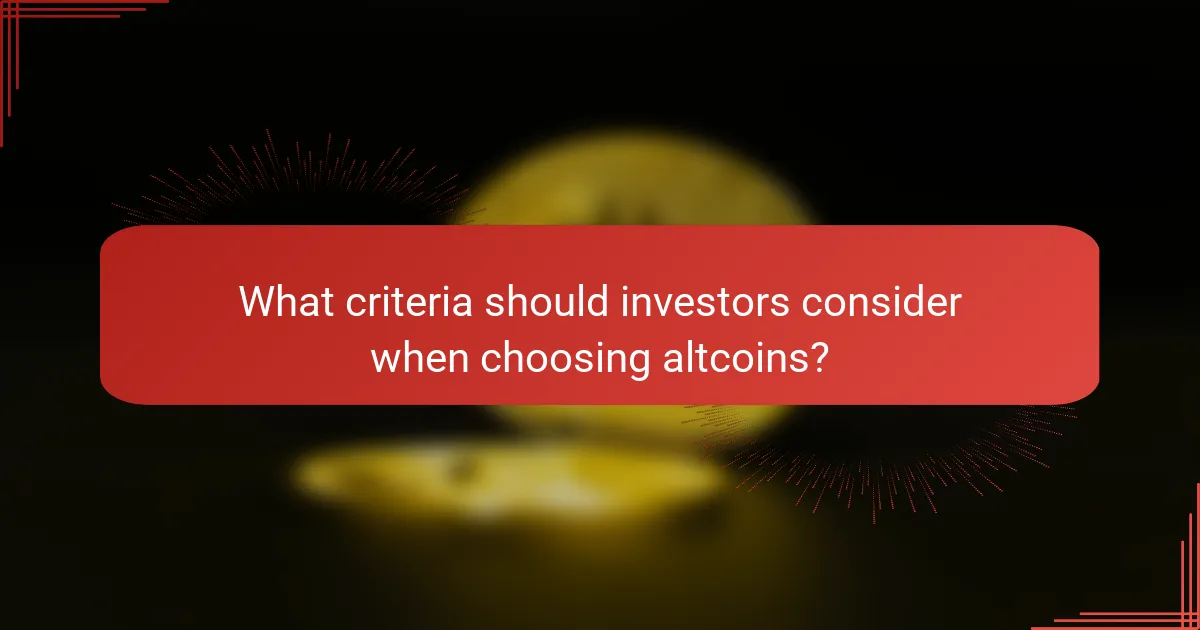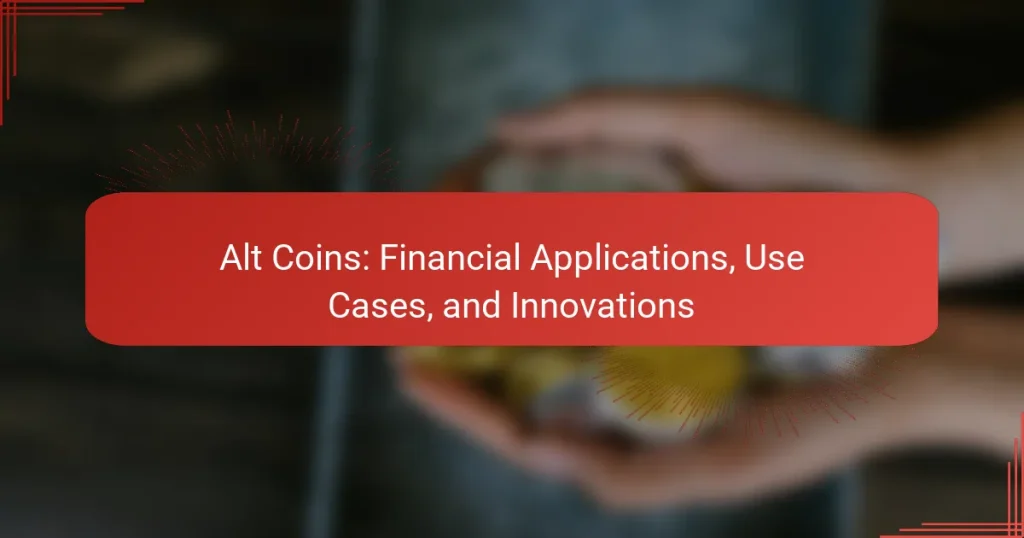Altcoins are revolutionizing the financial landscape by offering diverse applications that go beyond the capabilities of traditional cryptocurrencies. They play a crucial role in decentralized finance, cross-border transactions, and asset tokenization, providing innovative solutions tailored to specific industry needs. As technology advances, altcoins continue to evolve, enhancing their scalability, security, and functionality to meet the demands of a growing user base.

What are the financial applications of altcoins?
Altcoins serve various financial applications that extend beyond traditional cryptocurrencies, enhancing transactions and investment opportunities. They are increasingly utilized in decentralized finance, cross-border payments, and asset tokenization, among other innovative uses.
Decentralized finance (DeFi) platforms
DeFi platforms leverage altcoins to create financial services without intermediaries, allowing users to lend, borrow, and trade assets directly. These platforms often utilize smart contracts on blockchain networks, which automate transactions and reduce costs.
Popular DeFi applications include lending protocols like Aave and decentralized exchanges such as Uniswap. Users can earn interest on their crypto holdings or trade assets with minimal fees, making DeFi a compelling alternative to traditional finance.
Cross-border payments
Altcoins facilitate cross-border payments by providing a faster and cheaper alternative to traditional banking systems. Transactions can be completed in minutes, often at a fraction of the cost associated with wire transfers.
For example, using altcoins like Stellar or Ripple, businesses can send payments internationally with lower fees and reduced processing times compared to conventional methods. This is particularly beneficial for companies operating in multiple countries.
Tokenized assets
Tokenization involves converting physical assets into digital tokens on a blockchain, allowing for fractional ownership and easier transferability. Altcoins play a crucial role in this process by providing the necessary infrastructure and liquidity.
Real estate, art, and commodities can be tokenized, enabling investors to buy and sell fractions of these assets. This democratizes access to investment opportunities that were previously limited to wealthy individuals or institutions.
Remittances
Altcoins are increasingly used for remittances, allowing individuals to send money across borders quickly and affordably. Traditional remittance services often charge high fees and take several days to process transactions, whereas altcoins can significantly reduce both time and cost.
Services like SendFriend utilize altcoins to facilitate instant remittances, making it easier for migrant workers to send money back home. This can lead to substantial savings for both senders and recipients.
Microtransactions
Microtransactions, or small-value transactions, are made feasible by altcoins due to their low transaction fees and fast processing times. This is particularly useful for online content creators and service providers who want to monetize small purchases.
Platforms like Brave Browser use altcoins to reward users for viewing ads, allowing for seamless microtransactions that would be impractical with traditional payment methods. This opens new revenue streams for creators and enhances user engagement.

How are altcoins used in real-world scenarios?
Altcoins are utilized in various real-world applications that enhance financial transactions and operational efficiencies. These digital currencies serve specific purposes across industries, providing innovative solutions that traditional currencies may not offer.
Peer-to-peer lending
Peer-to-peer (P2P) lending platforms leverage altcoins to facilitate direct loans between individuals without intermediaries like banks. This process typically involves smart contracts that automate the lending terms, ensuring transparency and security.
For example, platforms like Aave or Compound allow users to lend and borrow cryptocurrencies, often with lower fees compared to traditional financial institutions. Borrowers can receive funds quickly, while lenders earn interest on their holdings.
Supply chain management
Altcoins are increasingly used in supply chain management to enhance traceability and reduce fraud. Blockchain technology enables real-time tracking of goods, ensuring that all parties have access to the same information.
For instance, VeChain uses its native token to verify product authenticity and monitor the movement of goods. This transparency can lead to improved efficiency and reduced costs in logistics.
Gaming and NFTs
In the gaming industry, altcoins play a crucial role in the creation and trading of non-fungible tokens (NFTs). These unique digital assets allow players to own in-game items, characters, or artwork securely on the blockchain.
Games like Axie Infinity utilize altcoins for transactions, enabling players to buy, sell, or trade their NFTs. This model not only enhances player engagement but also creates new revenue streams for developers.
Charity donations
Altcoins facilitate charitable donations by providing a transparent and efficient way to transfer funds. Blockchain technology ensures that donations can be tracked, giving donors confidence that their contributions are used as intended.
Platforms like BitGive utilize Bitcoin and other altcoins to support various charitable causes, allowing for lower transaction fees and faster processing times compared to traditional payment methods.
Identity verification
Altcoins are being used for identity verification processes, enhancing security and privacy. Blockchain technology allows users to control their personal information while providing proof of identity without revealing sensitive data.
Projects like Civic offer decentralized identity solutions, enabling users to verify their identities for services such as banking or online transactions. This approach reduces the risk of identity theft and enhances user trust in digital interactions.

What innovations are driving altcoin development?
Innovations in altcoin development are primarily driven by advancements in technology that enhance scalability, security, and functionality. These innovations address the limitations of traditional cryptocurrencies and introduce new use cases that appeal to a broader audience.
Layer 2 solutions
Layer 2 solutions are protocols built on top of existing blockchain networks to improve transaction speed and reduce costs. They allow for off-chain transactions, which can significantly lower congestion on the main chain, making them ideal for high-volume applications like payments and gaming.
Examples include the Lightning Network for Bitcoin and Optimistic Rollups for Ethereum. These solutions can process thousands of transactions per second, making them attractive for developers looking to create scalable applications.
Interoperability protocols
Interoperability protocols enable different blockchains to communicate and share data seamlessly. This innovation is crucial as it allows users to transfer assets across various networks without relying on centralized exchanges.
Notable examples include Polkadot and Cosmos, which facilitate cross-chain interactions. These protocols enhance the overall utility of altcoins by allowing them to work together, creating a more integrated ecosystem.
Privacy enhancements
Privacy enhancements in altcoins focus on providing users with greater anonymity and security in transactions. Technologies like zero-knowledge proofs and ring signatures obscure transaction details, making it difficult to trace the flow of funds.
Coins such as Monero and Zcash implement these privacy features, appealing to users who prioritize confidentiality. However, these enhancements can attract regulatory scrutiny, so developers must navigate compliance carefully.
Smart contract advancements
Smart contract advancements are revolutionizing how agreements are executed on the blockchain. These self-executing contracts automatically enforce and execute terms based on predefined conditions, reducing the need for intermediaries.
Ethereum remains the leading platform for smart contracts, but newer altcoins like Cardano and Solana are gaining traction with improved scalability and lower transaction fees. Developers should consider the specific features and limitations of each platform when choosing where to deploy their contracts.

What criteria should investors consider when choosing altcoins?
Investors should evaluate several key criteria when selecting altcoins, including market capitalization, technology, use case, and community support. These factors can significantly influence an altcoin’s potential for growth and stability.
Market capitalization
Market capitalization is a crucial indicator of an altcoin’s overall value and market presence. It is calculated by multiplying the current price of the coin by its total circulating supply. Generally, altcoins with higher market caps are considered more stable and less volatile than those with lower caps.
Investors often categorize altcoins based on their market capitalization: large-cap (over $10 billion), mid-cap ($1 billion to $10 billion), and small-cap (under $1 billion). Large-cap coins tend to be more established and less risky, while small-cap coins can offer higher growth potential but come with increased risk.
When considering market capitalization, investors should also look at trading volume and liquidity. High trading volumes indicate strong interest and can lead to more stable prices, while low liquidity can result in price manipulation and greater volatility.


